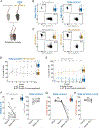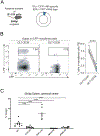Invasion of spontaneous germinal centers by naive B cells is rapid and persistent
- PMID: 38517953
- PMCID: PMC11152582
- DOI: 10.1126/sciimmunol.adi8150
Invasion of spontaneous germinal centers by naive B cells is rapid and persistent
Abstract
In autoreactive germinal centers (GC) initiated by a single rogue B cell clone, wild-type B cells expand and give rise to clones that target other autoantigens, known as epitope spreading. The chronic, progressive nature of epitope spreading calls for early interventions to limit autoimmune pathologies, but the kinetics and molecular requirements for wild-type B cell invasion and participation in GC remain largely unknown. With parabiosis and adoptive transfer approaches in a murine model of systemic lupus erythematosus, we demonstrate that wild-type B cells join existing GCs rapidly, clonally expand, persist, and contribute to autoantibody production and diversification. The invasion of autoreactive GCs by wild-type B cells required TLR7, B cell receptor specificity, antigen presentation, and type I interferon signaling. The adoptive transfer model provides a tool for identifying early events in the breaking of B cell tolerance in autoimmunity.
Conflict of interest statement
Competing interests:
The authors declare that they have no competing interests.
Figures





Update of
-
Invasion of spontaneous germinal centers by naive B cells is rapid and persistent.bioRxiv [Preprint]. 2023 Jun 1:2023.05.30.542805. doi: 10.1101/2023.05.30.542805. bioRxiv. 2023. Update in: Sci Immunol. 2024 Mar 22;9(93):eadi8150. doi: 10.1126/sciimmunol.adi8150. PMID: 37398148 Free PMC article. Updated. Preprint.
References
-
- Lipsky PE, Systemic lupus erythematosus: an autoimmune disease of B cell hyperactivity. Nat. Immunol. 2, 764–766 (2001). - PubMed
-
- Arbuckle MR, McClain MT, Rubertone MV, Scofield RH, Dennis GJ, James JA, Harley JB, Development of Autoantibodies before the Clinical Onset of Systemic Lupus Erythematosus. N. Engl. J. Med. 349, 1526–1533 (2003). - PubMed
-
- Wardemann H, Yurasov S, Schaefer A, Young JW, Meffre E, Nussenzweig MC, Predominant Autoantibody Production by Early Human B Cell Precursors. Science. 301, 1374–1377 (2003). - PubMed
-
- Deshmukh US, Gaskin F, Lewis JE, Kannapell CC, Fu SM, Mechanisms of Autoantibody Diversification to SLE-Related Autoantigens. Ann. N. Y. Acad. Sci. 987, 91–98 (2003). - PubMed
MeSH terms
Substances
Grants and funding
LinkOut - more resources
Full Text Sources
Medical
Molecular Biology Databases
Miscellaneous

